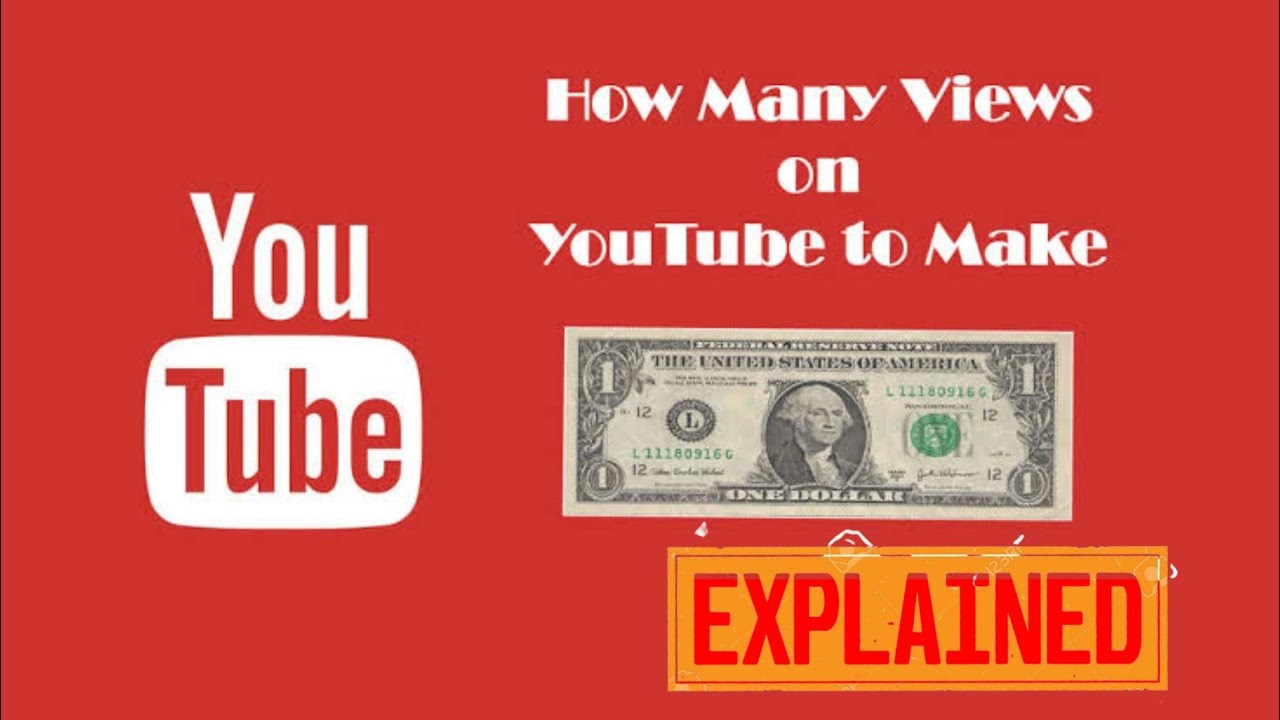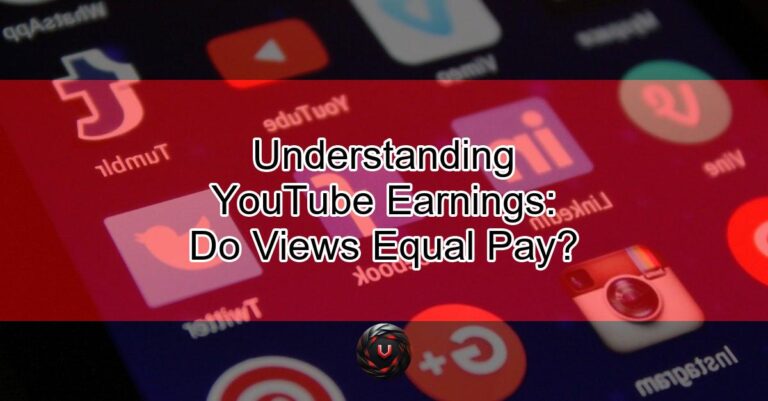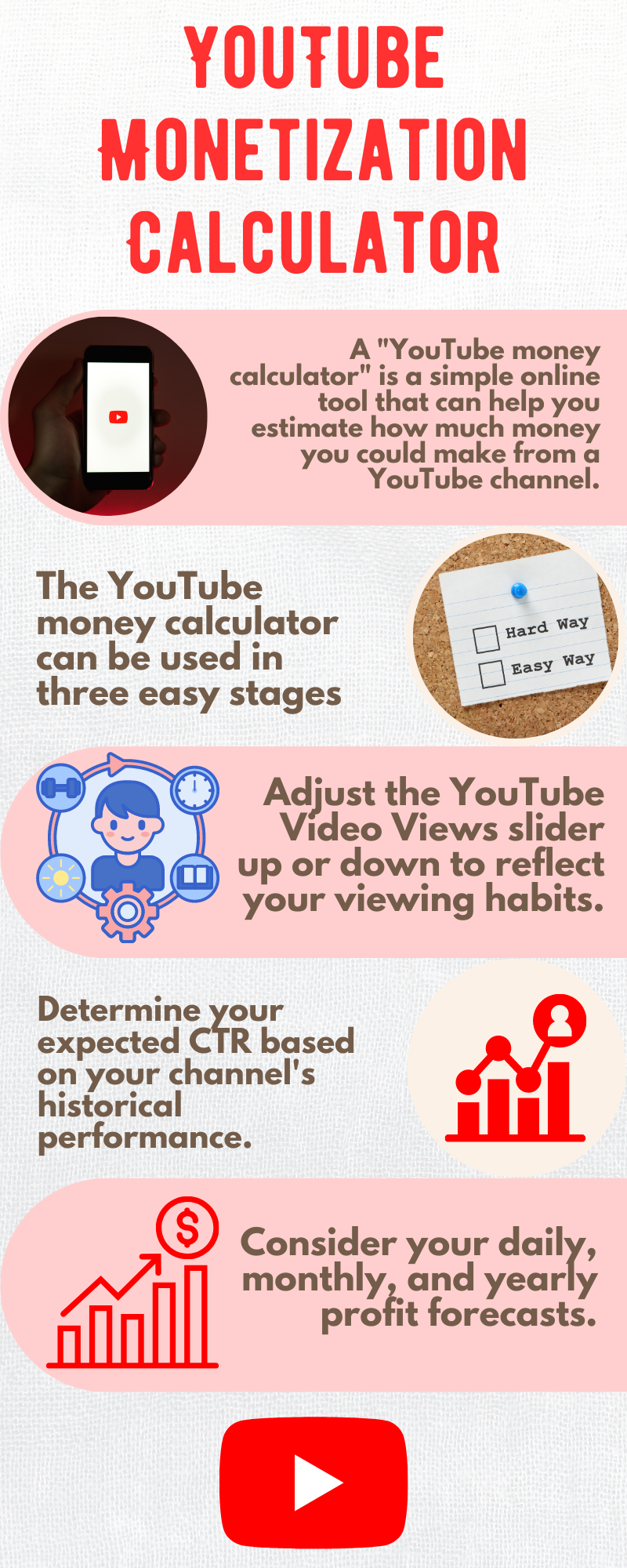Welcome to the fascinating world of YouTube earnings! If you've ever wondered how many views it takes to make a decent income on this platform, you're not alone. Many aspiring content creators dream of turning their passions into profits, but the truth is that YouTube monetization can be complex. In this post, we’ll break down the essentials of
The Basics of YouTube Monetization

YouTube monetization is the process by which creators earn money from their videos. To grasp how this works, you’ll need to be familiar with a few key factors. Here’s an overview of the main components involved:
- YouTube Partner Program (YPP): To start earning money, creators must join the YPP. This requires at least 1,000 subscribers and 4,000 watch hours over the past 12 months.
- Ad Revenue: The primary income stream for most YouTubers comes from ads displayed on their videos. Advertisers pay YouTube to showcase their products, and a portion of that revenue is shared with creators.
- Cost Per Mille (CPM): CPM refers to the amount advertisers pay per 1,000 ad views. This rate varies widely based on factors such as the video's content, audience demographics, and current trends. On average, CPM can range from $0.25 to $4 or more, but it can be higher for niches with lucrative advertisers.
- Views vs. Clicks: Not every view generates revenue. For earnings, viewers need to either watch the whole ad or click on it. Therefore, having high view counts alone doesn’t guarantee income unless those views translate into ad interactions.
- Other Revenue Streams: In addition to ad revenue, YouTubers can earn through methods like sponsorships, merchandise sales, Patreon, or fan funding. These can significantly boost earnings and provide more financial stability.
Now, let’s put this all together. To make $100, you’ll need to consider how these factors interplay. Assuming an average CPM of $2, you’d ideally need around 50,000 monetized views to reach that target. However, this figure can vary based on your niche, audience, and engagement levels. For instance, a gaming channel might have a different CPM than a finance-focused channel.
It’s important to remember that growth on YouTube takes time and effort. Creating high-quality content, engaging with your audience, and optimizing your videos for search can all influence your earnings. Many successful creators describe their journeys as a marathon, not a sprint. They invest time in building a community and refining their craft before seeing substantial financial returns.
In summary, understanding YouTube monetization is crucial for any aspiring creator. While the journey to earning that first $100 may seem daunting, focusing on creating great content and growing your audience can pave the way for financial success on the platform!
Also Read This: How to Upload a YouTube Video from iMovie: A Quick Process
3. How Many Views Equal $100 on YouTube?

When it comes to understanding how many views you need to earn $100 on YouTube, the math can get a bit tricky. The reason? YouTube monetization isn't a straightforward process. Instead, it relies on several variables, especially the Cost Per Mille (CPM) and the Click-Through Rate (CTR).
On average, CPM rates—the amount advertisers are willing to pay for a thousand ad impressions—can range anywhere from $0.25 to $10 and even higher, depending on your niche, audience location, and the time of year. For instance, if you create content related to finance or technology, your CPM might be on the higher end, whereas lifestyle or entertainment channels often see lower CPM rates.
Let’s break it down:
- Example 1: If your CPM is $5, you would need:
- 1000 views × ($5 / 1000) = $5 earned
- To make $100: You would need 20,000 views.
- Example 2: If your CPM is $2, you would need:
- 1000 views × ($2 / 1000) = $2 earned
- To make $100: You would need 50,000 views.
These numbers illustrate that the number of views needed to earn $100 can vary greatly. It all boils down to the CPM you experience on your channel. Don’t forget that these earnings are also affected by factors like viewer engagement and whether viewers actually watch the ads.
In summary, while there’s no definitive answer to how many views equal $100 on YouTube, 20,000 to 50,000 views is a good ballpark, but it’s essential to consider the type of content you create and your audience demographics for a clearer picture.
Also Read This: Por Qué YouTube Está Lento: Soluciones para Resolver el Problema
4. Factors Affecting YouTube Revenue

So, you’re probably wondering, “Why is my YouTube revenue fluctuating so much?” Great question! Several factors impact how much you can earn on the platform, and understanding them can help you strategize better. Here’s a closer look at some of those factors:
1. CPM Variability
The Cost Per Mille (CPM) is one of the most significant factors affecting your earnings. CPM can fluctuate based on:
- Content Category: Some niches naturally attract higher CPM rates. For example, financial or tech content usually pays more than lifestyle or beauty content.
- Seasonality: Advertisers spend more during holidays or major events, which can boost CPM rates during certain times of the year.
- Audience Location: Views from countries with higher advertising budgets (like the USA) typically yield a higher CPM compared to others.
2. Viewer Engagement
Engagement is key! Metrics like watch time, likes, shares, and comments not only signal that your content is valuable but can also affect how often your videos are promoted by YouTube. More visibility often leads to more views and, subsequently, higher earnings.
3. Ad Formats
The type of ads shown on your videos can also influence how much money you make. Some ads, like skippable video ads, may not earn as much as non-skippable ads, but they can lead to higher engagement since these ads are often less intrusive.
4. Monetization Settings
Don’t forget your monetization settings! Ensure that you have optimized settings for ads on your videos. Using multiple ad formats and placing ads appropriately can help enhance your overall revenue.
By keeping these factors in mind and continuously improving your content, you can get closer to that $100 mark, or maybe even surpass it!
Also Read This: How to Turn on Incognito Mode on YouTube
5. Calculating Your YouTube Earnings Potential

So, you’re ready to dive into the world of YouTube, and you're curious about how much you can earn. Understanding your YouTube earnings potential isn’t just about the number of views you accumulate; it involves various factors that contribute to your income stream. Let’s break this down.
First off, one of the key components in calculating your earnings is the Cost Per Mille (CPM), which is the amount advertisers pay for 1,000 views of their ad. While the CPM can fluctuate widely depending on your niche and audience, a typical CPM range is around $1 to $10. However, it's not uncommon for certain niches, like finance or technology, to see CPMs upwards of $20. Let’s take a closer look:
- Low CPM: $1 - $3 (e.g., lifestyle, vlogging)
- Average CPM: $4 - $8 (e.g., gaming, beauty)
- High CPM: $10 - $20+ (e.g., finance, technology)
Next, you need to consider your Audience Engagement. Not all views are equal. The interaction that viewers have with your content—likes, comments, and shares—can influence your earning potential. Advertisers prefer working with creators who have a highly engaged audience, which can lead to better CPM rates over time.
Now, let's talk about how many views are needed to reach that magic number of $100 in earnings. Assuming an average CPM of $5, you would need roughly 20,000 views to make $100. Here’s a simple formula you can use:
Views Needed = (Desired Earnings / CPM) 1000
For example, if your CPM is $5:
Views Needed = ($100 / $5) 1000 = 20,000 views
Additionally, keep in mind that YouTube also takes a cut from the ad revenue, typically around 45%. So, if you’re receiving a CPM of $5, you would actually earn around $2.75 per 1,000 views after YouTube’s share. This means you may need around 36,000 views to make $100 once YouTube's cut is factored in.
It’s important to note that various other monetization strategies can supplement your income, such as:
- Sponsorships
- Merchandise Sales
- Channel Memberships
- Affiliate Marketing
Incorporating these streams into your strategy can significantly enhance your earnings potential on YouTube, beyond just the ad revenue.
Also Read This: How a YouTube Downloader Works: Behind the Scenes of Video Tools
6. Common Myths About YouTube Earnings
As with any lucrative opportunity, YouTube earnings come with a fair share of myths and misconceptions. Let’s debunk some of the most common ones that could mislead aspiring creators.
Myth 1: YouTube is a Get-Rich-Quick Scheme
Many newcomers think that producing a few videos will yield instant wealth. The reality is that building a successful YouTube channel takes time, effort, and consistency. Overnight success is rare; most successful YouTubers spend months, if not years, honing their craft and engaging with their audience.
Myth 2: All You Need is Views
While views are important, they aren’t the only metric that matters. Your CPM, audience engagement, and niche all play significant roles in how much you can earn. Simply racking up views without fostering a loyal community won't lead to substantial income.
Myth 3: You Only Make Money from Ads
Many believe that ads are the only way to monetize a channel, but that’s far from the truth! Many creators leverage various revenue streams such as merchandise, crowdfunding platforms like Patreon, or even sponsorships from brands that align with their content.
Myth 4: YouTube Is Only for Young Creators
Age is just a number! YouTube is an open platform for everyone, and many successful YouTubers span a variety of age groups. Whether you’re a teen with fresh ideas or a retiree with a wealth of life experience, there’s always an audience for authentic content.
Myth 5: All You Need is a Camera
While having good equipment helps, it’s your content that matters most. Creators often forget that storytelling, creativity, and audience connection are key ingredients for success. A high-quality camera doesn’t outweigh engaging content. It’s about how you present your ideas!
Understanding these myths can help you approach your YouTube journey realistically, equipping you with the right mindset for growth and success. With dedication, creativity, and the right strategies, you can forge your path in the vibrant world of YouTube, moving beyond myth to reality!
Also Read This: Can YouTube Creators See Who Liked Their Videos? How Analytics Work for Creators
7. Strategies to Increase Your YouTube Views
So, you want to boost your YouTube views and inch closer to that sweet $100 mark? You’re not alone! Many creators search for the golden formula to get their videos in front of more eyeballs. Here are some proven strategies to help you increase your YouTube views effectively:
- Optimize Your Video Titles and Thumbnails: Your title is your first impression; make it catchy and relevant. Thumbnails are the visual hook that encourages clicks, so invest some time in creating eye-catching, high-quality thumbnails that clearly represent your content.
- Utilize SEO Techniques: Just like blogging, YouTube has its own search engine optimization (SEO) dynamics. Use relevant keywords in your video titles, descriptions, and tags. Research keywords using tools like Google Keyword Planner or TubeBuddy to find what your audience is searching for.
- Engage with Your Audience: Building a community can significantly impact your views. Respond to comments, ask viewers to like and share your videos, and create a call-to-action to boost engagement. The more you interact, the more likely viewers will return for more.
- Create Shareable Content: Think about what types of content your viewers will want to share with their friends and family. Tutorials, emotional stories, or entertaining challenges often do well. Content that resonates is more likely to get shared across social media platforms.
- Leverage Social Media: Promote your videos on various social media channels. Use Facebook, Twitter, Instagram, and TikTok to draw attention to your YouTube content. Each platform has its audience, so tailor your pitch accordingly.
- Collaborate with Other Creators: Partnering with other YouTubers can widen your reach. Look for creators in your niche who have a similar or slightly larger audience, and propose collaboration ideas that would benefit both parties. This exposes you to their viewers and can lead to a mutual growth of subscribers.
- Consistency is Key: Regularly upload videos to keep your audience engaged. Whether it's weekly or bi-weekly, stick to a schedule that works for you and let your audience know when to expect new content.
- Analyze Your Metrics: Keep an eye on YouTube Analytics to see what’s working and what isn’t. Look at your watch time, click-through rates, and audience demographics to tailor your future content accordingly. This continuous improvement will help you grow.
By implementing these strategies, you’ll not only increase your views but also foster a loyal community that can help you reach your monetization goals. Remember, it’s all about quality content and engaging with your audience — put in the effort, and the views will follow!
8. Conclusion: Maximizing Your YouTube Revenue
Reaching the milestone of $100 in earnings on YouTube is not merely about gathering views; it’s a combination of strategy, creativity, and consistency. To summarize, here’s what you need to focus on:
- Quality Content: Always prioritize producing high-quality, engaging content that meets the needs and interests of your audience.
- Build Your Brand: The more recognizable and relatable your brand becomes, the more likely viewers will want to engage with your content. Consider your niche, style, and how you want to present yourself.
- Diverse Revenue Streams: Don't rely solely on ad revenue. Explore sponsorships, merchandise, memberships, and affiliate marketing to diversify your income sources.
- Network and Collaborate: Building relationships within the YouTube community can lead to opportunities for collaborations, cross-promotions, and greater exposure.
- Continuous Learning: Stay updated with YouTube’s algorithm changes and market trends to adapt your strategies as needed. Attend workshops, join creators' groups, or read up on current social media trends.
Remember, achieving financial success on YouTube takes patience and persistence. It might be tempting to chase viral trends, but sustainable growth will come from building a solid foundation with your audience. With the right mindset and strategies in place, you’ll not only reach that $100 goal but far surpass it! Keep creating, stay passionate, and the results will follow.
 admin
admin








